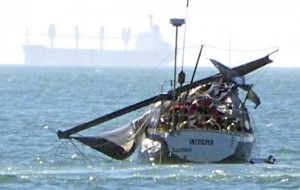Daria Blackwell details instances of collisions with whales past and present
The first I heard about a sailing boat colliding with a whale mid-ocean was when the 49ft sloop Peningo had a whale encounter 700 miles from the Azores while en route from the US to the America’s Cup Jubilee in the UK. The skipper called their story Struck by a Whale, but it is more likely that it was the vessel that struck a sleeping whale. The whale was severely injured and the yacht was disabled with rudder damage. Fortunately, Peningo remained afloat until a rescue ship arrived. The whale may not have done so well.
Back in 1820 the Nantucket whaling ship, Essex, was sunk by a sperm whale (Physeter catodon) in the South Pacific – Herman Melville based Moby-Dick on the story. As told by the crew who survived, the whale struck the ship with its head while the light boats were hunting. The whale smashed through the bulkhead and water was streaming in.
The whale was apparently injured, twisting in convulsions some distance away. Suddenly, the animal raced toward the ship again, its head high above the water like a battering ram. It stove in the port side of the ship. The Essex sank and the crew were left thousands of miles from land in three light boats. The sperm whale, at 60ft in length and weighing 50 tons, is the largest toothed animal alive.
During a passage from the Canaries to the Caribbean, a 35ft boat in our SSB net reported being attacked by a whale. While under sail in light wind, they sighted several whales, one of which turned toward their boat and rammed it head on. It circled and came back at them repeatedly.
They were terrified that it might hole the vessel, but it suddenly swam away. They identified it as a false killer whale (Pseudorca crassidens). The net controller asked what colour their hull was, as a crewmember suggested that whales attack boats with red bottoms. Interestingly, they had just repainted their bottom red.
Multiple reports of vessels colliding with whales include two British yachts lost in the 1970s. Dougal Robertson set sail in 1971 aboard Lucette, a 43ft wooden schooner, with his wife and four children. On 15 June 1972 she was holed by a pod of killer whales (Orcinus orca) and sank 200 miles west of the Galapagos. The family escaped to an inflatable liferaft and a dinghy, and were rescued after 38 days by a fishing trawler. Afterwards Robertson wrote the classics Survive the Savage Sea and Sea Survival: A Manual.
The Baileys were transiting from Panama to the Galapagos when, on 4 March 1973, 31ft Auralyn was struck by a whale and holed. The crew drifted 1,500 miles in an inflatable liferaft before being rescued. The account of their ordeal is entitled 117 Days Adrift.
In June 2009, a British couple sailing their 47ft yacht near the British Virgin Islands struck a whale in the early morning, holing the hull. They abandoned ship and awaited rescue. There is no information on injuries to the whale.

These photos were posted online by James Dagmore showing the yacht Intrepid being damaged by a whale off Cape Town
How likely is a collision with a whale and how can you reduce the chances?
Whale strikes on racing yachts
- Among four reports of collisions during the OSTAR (one in 1964, two in 1988, and one in 1996), one involved Ellen MacArthur’s Kingfisher in which the dead whale was found wrapped around the keel.
- David Selling’s Hyccup sank as a result of a collision in 1988. In the second of two reports from Whitbread races in 1989 and 1998, Knut Frostad said: “It was like being in a car crash.”
- In the Artemis Transat solo race in 2008, several vessels reported striking whales, although one was possibly a whale shark. Two of the strikes were catastrophic for the vessels.
- In the Portimão Global Ocean Race in 2008, two 40ft yachts reported striking whales. Neither vessel suffered significant damage.
- In 2008, two IMOCA 60s in the Vendée Globe struck whales; both lost their keels, but were able to continue on to safe harbour.
- Delta Lloyd and Ericsson 3 both hit whales during the 2008-2009 Volvo Ocean Race, with minor damage. There were four other reports during previous races in which boats were damaged, rudders being particularly vulnerable.
- In 2009 the 40ft J/120 J/World was sailing in the Baja Ha-Ha Cruising Rally from California to Mexico at about nine knots when a crewmember spotted a humpback whale (Megoptera novaeangliae) 60m to port. A second whale was spotted to starboard. Another two whales were seen 15m ahead, but before any diversionary action could be taken, J/World struck a whale with the keel. It felt as though the vessel had run aground. Her propeller hit the animal and blood was seen.
The owner believed the whale then struck the vessel with its tail, jamming the rudder post up and aft, holing the transom. The vessel sank within 45 minutes. The crew took to the liferaft and were rescued by the USCG. There is no information about the whale.
This is an extract from a feature in Yachting World January 2015





